Deck 6: Direct-Current Circuits
Question
Question
Question
Question
Question
Question
Question
Question
Question
Question
Question
Question
Question
Question
Question
Question
Question
Question
Question
Question
Question
Question
Question
Question
Question
Question
Question
Question
Question
Question
Question
Question
Question
Question
Question
Question
Question
Question
Question
Question
Question
Question
Question
Question
Question
Question
Question
Question
Question

Unlock Deck
Sign up to unlock the cards in this deck!
Unlock Deck
Unlock Deck
1/49
Play
Full screen (f)
Deck 6: Direct-Current Circuits
1
When a 20-V emf is placed across two resistors in series, a current of 2.0 A is present in each of the resistors.When the same emf is placed across the same two resistors in parallel, the current through the emf is 10 A.What is the magnitude of the greater of the two resistances?
A)7.2
B)7.6
C)6.9
D)8.0
E)2.8
A)7.2
B)7.6
C)6.9
D)8.0
E)2.8
7.2
2
Determine the magnitude and sense (direction) of the current in the 500- resistor when I = 30 mA. 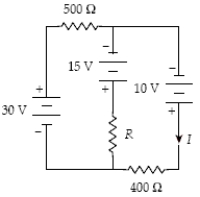
A)56 mA left to right
B)56 mA right to left
C)48 mA left to right
D)48 mA right to left
E)26 mA left to right

A)56 mA left to right
B)56 mA right to left
C)48 mA left to right
D)48 mA right to left
E)26 mA left to right
56 mA left to right
3
At t = 0 the switch S is closed with the capacitor uncharged.If C = 50 F, = 20 V, and R = 4.0 k , what is the charge on the capacitor when I = 2.0 mA? 
A)360 C
B)480 C
C)240 C
D)600 C
E)400 C

A)360 C
B)480 C
C)240 C
D)600 C
E)400 C
600 C
4
At t = 0 the switch S is closed with the capacitor uncharged.If C = 40 F, = 50 V, and R = 5.0 k , how much energy is stored by the capacitor when I = 2.0 mA? 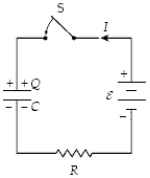
A)20 mJ
B)28 mJ
C)32 mJ
D)36 mJ
E)40 mJ

A)20 mJ
B)28 mJ
C)32 mJ
D)36 mJ
E)40 mJ

Unlock Deck
Unlock for access to all 49 flashcards in this deck.
Unlock Deck
k this deck
5
In an RC circuit, how many time constants must elapse if an initially uncharged capacitor is to reach 80% of its final potential difference?
A)2.2
B)1.9
C)1.6
D)3.0
E)5.0
A)2.2
B)1.9
C)1.6
D)3.0
E)5.0

Unlock Deck
Unlock for access to all 49 flashcards in this deck.
Unlock Deck
k this deck
6
What is the current in the 10- resistor ? 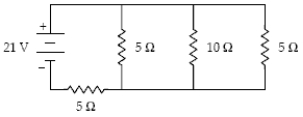
A)0.60 A
B)3.0 A
C)1.2 A
D)2.4 A
E)0.30 A

A)0.60 A
B)3.0 A
C)1.2 A
D)2.4 A
E)0.30 A

Unlock Deck
Unlock for access to all 49 flashcards in this deck.
Unlock Deck
k this deck
7
If Q = 400 C and the potential difference VA - VB =-V in the circuit segment shown below, what is the current in the resistor? 
A)1.0 mA right to left
B)1.0 mA left to right
C)3.5 mA right to left
D)3.5 mA left to right
E)None of the above

A)1.0 mA right to left
B)1.0 mA left to right
C)3.5 mA right to left
D)3.5 mA left to right
E)None of the above

Unlock Deck
Unlock for access to all 49 flashcards in this deck.
Unlock Deck
k this deck
8
Determine the potential difference Va - Vb shown in the circuit below. 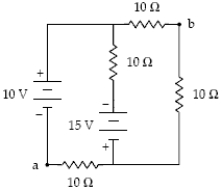
A)(-5.0 V)
B)+5.0 V
C)(-10 V)
D)+10 V
E)0 V

A)(-5.0 V)
B)+5.0 V
C)(-10 V)
D)+10 V
E)0 V

Unlock Deck
Unlock for access to all 49 flashcards in this deck.
Unlock Deck
k this deck
9
How much heat is produced in the 10- resistor in 5.0 s when = 18 V? 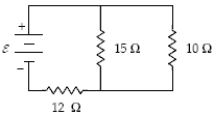
A)72 J
B)32 J
C)50 J
D)18 J
E)90 J

A)72 J
B)32 J
C)50 J
D)18 J
E)90 J

Unlock Deck
Unlock for access to all 49 flashcards in this deck.
Unlock Deck
k this deck
10
What is the current in the 15- resistor when = 9.0 V? 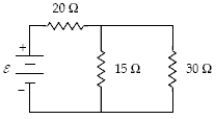
A)0.20 A
B)0.30 A
C)0.10 A
D)0.26 A
E)0.60 A

A)0.20 A
B)0.30 A
C)0.10 A
D)0.26 A
E)0.60 A

Unlock Deck
Unlock for access to all 49 flashcards in this deck.
Unlock Deck
k this deck
11
If 1 = 4.0 V, 2 = 12.0 V, R1 = 4 , R2 = 12 , C = 3 F, Q = 18 C, and I = 2.5 A, what is the potential difference Va-Vb? 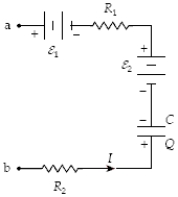
A)(-30 V)
B)30 V
C)5.0 V
D)(-5.0 V)
E)(-1.0 V)

A)(-30 V)
B)30 V
C)5.0 V
D)(-5.0 V)
E)(-1.0 V)

Unlock Deck
Unlock for access to all 49 flashcards in this deck.
Unlock Deck
k this deck
12
How long will it take a charged 80- F capacitor to lose 20% of its initial energy when it is allowed to discharge through a 45- resistor?
A)0.92 ms
B)0.64 ms
C)0.40 ms
D)0.19 ms
E)0.80 ms
A)0.92 ms
B)0.64 ms
C)0.40 ms
D)0.19 ms
E)0.80 ms

Unlock Deck
Unlock for access to all 49 flashcards in this deck.
Unlock Deck
k this deck
13
What is the magnitude of the potential difference across the 20- resistor? 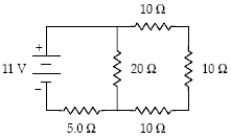
A)3.2 V
B)7.8 V
C)11 V
D)5.0 V
E)8.6 V

A)3.2 V
B)7.8 V
C)11 V
D)5.0 V
E)8.6 V

Unlock Deck
Unlock for access to all 49 flashcards in this deck.
Unlock Deck
k this deck
14
What is the potential difference VB - VA when the I = 1.5 A in the circuit segment below? 
A)+22 V
B)(-22 V)
C)(-38 V)
D)+38 V
E)+2.0 V

A)+22 V
B)(-22 V)
C)(-38 V)
D)+38 V
E)+2.0 V

Unlock Deck
Unlock for access to all 49 flashcards in this deck.
Unlock Deck
k this deck
15
At what rate is thermal energy being generated in the 2R-resistor when = 12 V and R = 3.0 ? 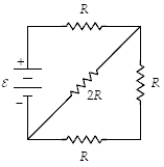
A)12 W
B)24 W
C)6.0 W
D)3.0 W
E)1.5 W

A)12 W
B)24 W
C)6.0 W
D)3.0 W
E)1.5 W

Unlock Deck
Unlock for access to all 49 flashcards in this deck.
Unlock Deck
k this deck
16
Determine the resistance R when I = 1.5 A. 
A)40
B)8.0
C)85
D)28
E)32

A)40
B)8.0
C)85
D)28
E)32

Unlock Deck
Unlock for access to all 49 flashcards in this deck.
Unlock Deck
k this deck
17
A capacitor in a single-loop RC circuit is charged to 85% of its final potential difference in 2.4 s.What is the time constant for this circuit?
A)1.5 s
B)1.3 s
C)1.7 s
D)1.9 s
E)2.9 s
A)1.5 s
B)1.3 s
C)1.7 s
D)1.9 s
E)2.9 s

Unlock Deck
Unlock for access to all 49 flashcards in this deck.
Unlock Deck
k this deck
18
Determine R when I = 0.20 A and = 18 V. 
A)50
B)8.0
C)10
D)20
E)30

A)50
B)8.0
C)10
D)20
E)30

Unlock Deck
Unlock for access to all 49 flashcards in this deck.
Unlock Deck
k this deck
19
If the current in the 4.0- resistor is 1.4 A, what is the magnitude of the potential difference, VA -VB? 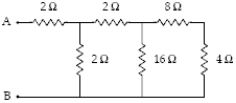
A)69 V
B)55 V
C)62 V
D)48 V
E)31 V

A)69 V
B)55 V
C)62 V
D)48 V
E)31 V

Unlock Deck
Unlock for access to all 49 flashcards in this deck.
Unlock Deck
k this deck
20
What is the magnitude of the current in the 20- resistor? 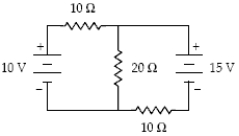
A)0.75 A
B)0.00 A
C)0.25 A
D)0.50 A
E)1.00 A

A)0.75 A
B)0.00 A
C)0.25 A
D)0.50 A
E)1.00 A

Unlock Deck
Unlock for access to all 49 flashcards in this deck.
Unlock Deck
k this deck
21
The circuit below contains three 100-W light bulbs and a capacitor.The emf = 110V.At the instant the switch S is closed, which light bulb is brightest? 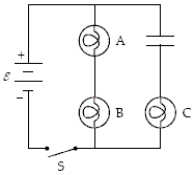
A)A
B)B
C)C
D)A and B
E)All three are equally bright.

A)A
B)B
C)C
D)A and B
E)All three are equally bright.

Unlock Deck
Unlock for access to all 49 flashcards in this deck.
Unlock Deck
k this deck
22
The circuit below contains 4 100-W light bulbs.The emf is 110 V.Which light bulb(s) is(are) brightest? 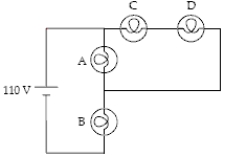
A)A
B)B
C)C
D)D
E)C and D

A)A
B)B
C)C
D)D
E)C and D

Unlock Deck
Unlock for access to all 49 flashcards in this deck.
Unlock Deck
k this deck
23
If R1 = 10 , R2 = 15 , R3 = 20 , and I = 0.50 A, at what rate is heat being generated in these resistors? 
A)29 W
B)16 W
C)22 W
D)11 W
E)1.1 W

A)29 W
B)16 W
C)22 W
D)11 W
E)1.1 W

Unlock Deck
Unlock for access to all 49 flashcards in this deck.
Unlock Deck
k this deck
24
If R1 = 3.0 , R2 = 6.0 , R3 = 12 , and I = 0.50 A, at what rate is heat being generated in R1? 
A)20 W
B)17 W
C)12 W
D)31 W
E)6.0 W

A)20 W
B)17 W
C)12 W
D)31 W
E)6.0 W

Unlock Deck
Unlock for access to all 49 flashcards in this deck.
Unlock Deck
k this deck
25
Which of the identical light bulb(s) is(are) brightest when the capacitor has half its maximum charge? 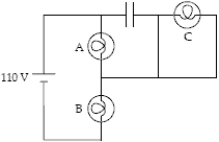
A)A
B)B
C)C
D)A and B
E)All three are equally bright.

A)A
B)B
C)C
D)A and B
E)All three are equally bright.

Unlock Deck
Unlock for access to all 49 flashcards in this deck.
Unlock Deck
k this deck
26
What is the equivalent resistance between points a and b when R = 30 ? 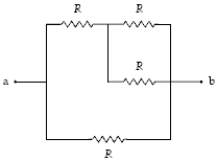
A)27
B)21
C)24
D)18
E)7.5

A)27
B)21
C)24
D)18
E)7.5

Unlock Deck
Unlock for access to all 49 flashcards in this deck.
Unlock Deck
k this deck
27
The circuit below contains three 100-watt light bulbs.The emf = 110 V.Which light bulb(s) is(are) the brightest? 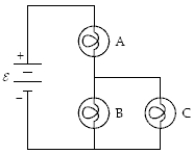
A)A
B)B
C)C
D)B and C
E)All three are equally bright.

A)A
B)B
C)C
D)B and C
E)All three are equally bright.

Unlock Deck
Unlock for access to all 49 flashcards in this deck.
Unlock Deck
k this deck
28
The circuit below contains 3100-W light bulbs and a capacitor.The emf is 110 V.Which light bulb(s) is(are) brightest? (Assume the capacitor is fully charged.) 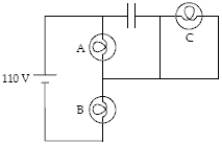
A)A
B)B
C)C
D)A and B
E)All three are equally bright.

A)A
B)B
C)C
D)A and B
E)All three are equally bright.

Unlock Deck
Unlock for access to all 49 flashcards in this deck.
Unlock Deck
k this deck
29
The capacitors are completely discharged in the circuit shown below. 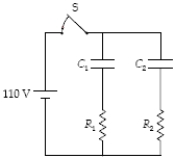 The two resistors have the same resistance R and the two capacitors have the same capacitance C.After the switch is closed, the current:
The two resistors have the same resistance R and the two capacitors have the same capacitance C.After the switch is closed, the current:
A)is greatest in C1.
B)is greatest in C2.
C)is greatest in R1.
D)is greatest in R2.
E)is the same in C1, C2, R1 and R2.
 The two resistors have the same resistance R and the two capacitors have the same capacitance C.After the switch is closed, the current:
The two resistors have the same resistance R and the two capacitors have the same capacitance C.After the switch is closed, the current:A)is greatest in C1.
B)is greatest in C2.
C)is greatest in R1.
D)is greatest in R2.
E)is the same in C1, C2, R1 and R2.

Unlock Deck
Unlock for access to all 49 flashcards in this deck.
Unlock Deck
k this deck
30
In a loop in a closed circuit, the sum of the currents entering a junction equals the sum of the currents leaving a junction because:
A)the potential of the nearest battery is the potential at the junction.
B)there are no transformations of energy from one type to another in a circuit loop.
C)capacitors tend to maintain current through them at a constant value.
D)current is used up after it leaves a junction.
E)charge is neither created nor destroyed at a junction.
A)the potential of the nearest battery is the potential at the junction.
B)there are no transformations of energy from one type to another in a circuit loop.
C)capacitors tend to maintain current through them at a constant value.
D)current is used up after it leaves a junction.
E)charge is neither created nor destroyed at a junction.

Unlock Deck
Unlock for access to all 49 flashcards in this deck.
Unlock Deck
k this deck
31
A certain brand of hot dog cooker applies a potential difference (120 V) to opposite ends of the hot dog and cooks by means of the joule heat produced.If 60 kJ is needed to cook each hot dog, what current is needed to cook four hot dogs simultaneously in 3.0 min?
A)11 A
B)2.8 A
C)8.3 A
D)2.1 A
E)3.6 A
A)11 A
B)2.8 A
C)8.3 A
D)2.1 A
E)3.6 A

Unlock Deck
Unlock for access to all 49 flashcards in this deck.
Unlock Deck
k this deck
32
When a capacitor is fully charged, the current through the capacitor in a direct-current circuit is:
A)zero.
B)at its maximum value.
C)equal to the current in a resistive circuit in parallel with the capacitor circuit.
D)greater than the current in a resistor that is farther from the battery than the capacitor.
E)zero if it is the only capacitor, but maximum if there is another capacitor in series with it.
A)zero.
B)at its maximum value.
C)equal to the current in a resistive circuit in parallel with the capacitor circuit.
D)greater than the current in a resistor that is farther from the battery than the capacitor.
E)zero if it is the only capacitor, but maximum if there is another capacitor in series with it.

Unlock Deck
Unlock for access to all 49 flashcards in this deck.
Unlock Deck
k this deck
33
The circuit below contains three resistors, A, B, and C, which all have equal resistances.The emf = 110V.Which resistor generates the most thermal energy after the switch is closed? 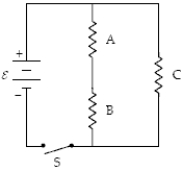
A)A
B)B
C)C
D)A and B
E)All three generate equal amounts of thermal energy.

A)A
B)B
C)C
D)A and B
E)All three generate equal amounts of thermal energy.

Unlock Deck
Unlock for access to all 49 flashcards in this deck.
Unlock Deck
k this deck
34
Which two circuits are exactly equivalent? 
A)A and B
B)B and C
C)C and D
D)D and E
E)B and E

A)A and B
B)B and C
C)C and D
D)D and E
E)B and E

Unlock Deck
Unlock for access to all 49 flashcards in this deck.
Unlock Deck
k this deck
35
The diagram shown represents a portion of a wire in a circuit.A current is flowing in the wire in the direction shown.Under the convention that it is positive charge that flows the electric field points in the direction of the current.How can the electric field change direction where the wire bends? 
A)There is an excess of negative charge in the centre of the wire.
B)There is an excess of positive charge at the bottom end of the wire.
C)There is an excess of negative charge at the right end of the upper portion of the wire.
D)There is an accumulation of positive charge on the surface, particularly at the bend, such that the sum of electric fields gives the new electric field.
E)There is an accumulation of electrical potential as the current traverses the wire.The higher potential in the lower half is the source of the field.

A)There is an excess of negative charge in the centre of the wire.
B)There is an excess of positive charge at the bottom end of the wire.
C)There is an excess of negative charge at the right end of the upper portion of the wire.
D)There is an accumulation of positive charge on the surface, particularly at the bend, such that the sum of electric fields gives the new electric field.
E)There is an accumulation of electrical potential as the current traverses the wire.The higher potential in the lower half is the source of the field.

Unlock Deck
Unlock for access to all 49 flashcards in this deck.
Unlock Deck
k this deck
36
What is the equivalent resistance between points a and b when R = 13 ? 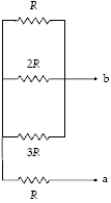
A)29
B)23
C)26
D)20
E)4.6

A)29
B)23
C)26
D)20
E)4.6

Unlock Deck
Unlock for access to all 49 flashcards in this deck.
Unlock Deck
k this deck
37
The circuit below contains three 100-watt light bulbs and a capacitor.The emf = 110V.The capacitor is fully charged.Which light bulb(s) is(are) dimmest? 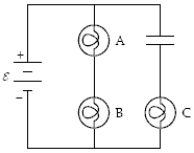
A)A
B)B
C)C
D)A and B
E)All three are equally bright (or dim).

A)A
B)B
C)C
D)A and B
E)All three are equally bright (or dim).

Unlock Deck
Unlock for access to all 49 flashcards in this deck.
Unlock Deck
k this deck
38
What is the equivalent resistance between points A and B in the figure when R = 18 ? 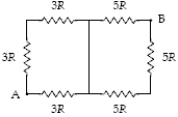
A)48
B)64
C)80
D)96
E)110

A)48
B)64
C)80
D)96
E)110

Unlock Deck
Unlock for access to all 49 flashcards in this deck.
Unlock Deck
k this deck
39
The circuit below contains three 100-W light bulbs.The emf = 110 V.Which light bulb(s) is(are) brightest? 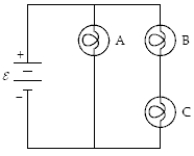
A)A
B)B
C)C
D)B and C
E)All three are equally bright.

A)A
B)B
C)C
D)B and C
E)All three are equally bright.

Unlock Deck
Unlock for access to all 49 flashcards in this deck.
Unlock Deck
k this deck
40
The circuit below contains 5 identical light bulbs.The emf is 110 V.Which light bulb(s) is(are) brightest? 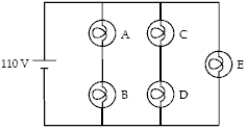
A)A: The one closest to the positive terminal of the battery.
B)A and C: The bulbs closest to the positive terminal of the battery.
C)A and B: Because they are closest to the terminals of the battery.
D)C and D: Because they receive current from A and B and from E.
E)E: Because the potential difference across E is that of the battery.

A)A: The one closest to the positive terminal of the battery.
B)A and C: The bulbs closest to the positive terminal of the battery.
C)A and B: Because they are closest to the terminals of the battery.
D)C and D: Because they receive current from A and B and from E.
E)E: Because the potential difference across E is that of the battery.

Unlock Deck
Unlock for access to all 49 flashcards in this deck.
Unlock Deck
k this deck
41
A battery has an internal resistance of 4.0 .Which of the following load resistors would have the most power delivered to it when connected across the battery?
A)1.4
B)2.0
C)4.0
D)8.0
E)16
A)1.4
B)2.0
C)4.0
D)8.0
E)16

Unlock Deck
Unlock for access to all 49 flashcards in this deck.
Unlock Deck
k this deck
42
A circuit consists of 2N resistors, all of resistance R, connected as shown below.A potential difference V is applied to one end, and the other end is at ground potential.The equivalent resistance of the circuit is: 
A)
B)R.
C)
D)NR.
E)2NR.

A)

B)R.
C)

D)NR.
E)2NR.

Unlock Deck
Unlock for access to all 49 flashcards in this deck.
Unlock Deck
k this deck
43
A parallel circuit consists of a 100 V DC power source, a 100 resistor, and a variable resistor of resistance R, which varies from 0 to 100 .The current in the circuit is: 
A)directly proportional to R.
B)inversely proportional to R.
C)directly proportional to (100 + R).
D)inversely proportional to (100 + R).
E)neither directly nor inversely proportional to R or to (100 + R).

A)directly proportional to R.
B)inversely proportional to R.
C)directly proportional to (100 + R).
D)inversely proportional to (100 + R).
E)neither directly nor inversely proportional to R or to (100 + R).

Unlock Deck
Unlock for access to all 49 flashcards in this deck.
Unlock Deck
k this deck
44
The circuit below shows three resistors in series.R3 > R2 > R1.The resistors are all made of the same wire with the same diameter but have different lengths.Rank the magnitudes of the electric fields in the resistors from least to greatest. 
A)E3 < E2 < E1.
B)E2 < E1 = E3.
C)E1 = E2 = E3.
D)E1 = E3 < E2.
E)E1 < E2 < E3.

A)E3 < E2 < E1.
B)E2 < E1 = E3.
C)E1 = E2 = E3.
D)E1 = E3 < E2.
E)E1 < E2 < E3.

Unlock Deck
Unlock for access to all 49 flashcards in this deck.
Unlock Deck
k this deck
45
The circuit below shows three resistors in parallel.R3 > R2 > R1.The resistors are all made of the same wire with the same diameter but have different lengths.Rank the magnitudes of the electric fields in the resistors from least to greatest. 
A)E3 < E2 < E1.
B)E2 < E1 = E3.
C)E1 = E2 = E3.
D)E1 = E3 < E2.
E)E1 < E2 < E3.

A)E3 < E2 < E1.
B)E2 < E1 = E3.
C)E1 = E2 = E3.
D)E1 = E3 < E2.
E)E1 < E2 < E3.

Unlock Deck
Unlock for access to all 49 flashcards in this deck.
Unlock Deck
k this deck
46
What is the maximum number of 100-W light bulbs you can connect in parallel in a 120-V home circuit without tripping the 20-A circuit breaker?

Unlock Deck
Unlock for access to all 49 flashcards in this deck.
Unlock Deck
k this deck
47
An initially uncharged 10- F capacitor is charged by a 10-V battery through a resistance R.The capacitor reaches a potential difference of 4 V in a period of 3 s after the charging began.Find the value of R.

Unlock Deck
Unlock for access to all 49 flashcards in this deck.
Unlock Deck
k this deck
48
A series circuit consists of a 100 V DC power source, a 100 resistor, and a variable resistor of resistance R, which varies from 0 to 100 .The current in the circuit is: 
A)directly proportional to R.
B)inversely proportional to R.
C)directly proportional to (100 + R).
D)inversely proportional to (100 + R).
E)neither directly nor inversely proportional to R or to (100 + R).

A)directly proportional to R.
B)inversely proportional to R.
C)directly proportional to (100 + R).
D)inversely proportional to (100 + R).
E)neither directly nor inversely proportional to R or to (100 + R).

Unlock Deck
Unlock for access to all 49 flashcards in this deck.
Unlock Deck
k this deck
49
A 5000- resistor and a 50- F capacitor are connected in series at t = 0 with a 6-V battery.The capacitor is initially uncharged.What is the current in the circuit at t = 0? At t = 0.5 s? What is the maximum charge stored on the capacitor?

Unlock Deck
Unlock for access to all 49 flashcards in this deck.
Unlock Deck
k this deck



